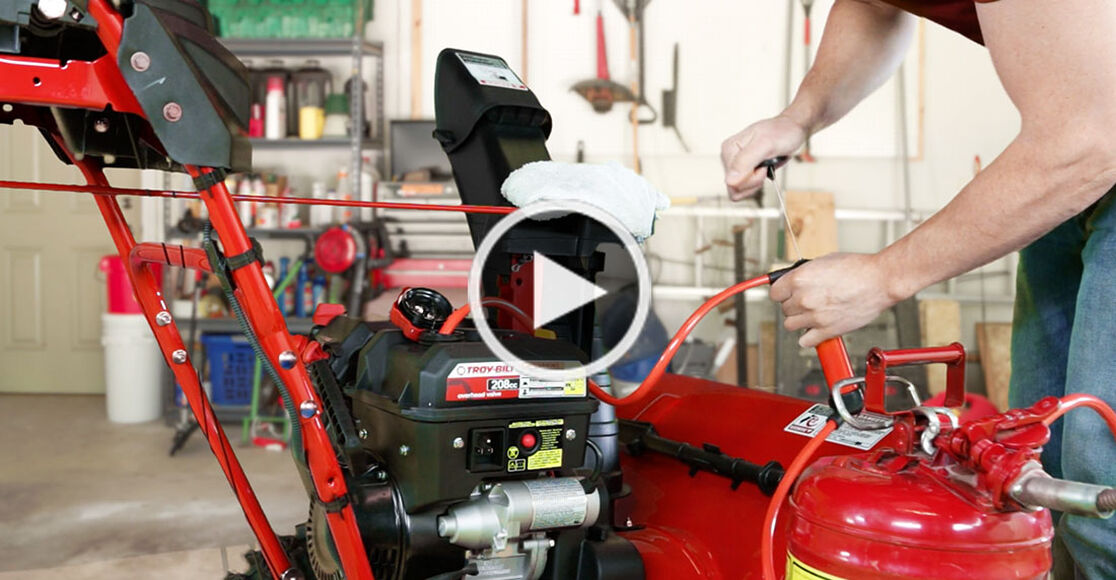Believe it or not, there will come a time to put the snow blower away for the season. And while it may be easy – and perhaps provide a sense of relief – to just push it to the back of the garage, there are a handful of tasks to carry out to store your equipment properly. Neglecting to do so can cause starting or operating issues next winter. Keep in mind, some storage requirements and instructions differ between single-stage and two-stage units, but this guide will help walk you through the necessary steps to store your snow blower correctly.
Maintenance Preparation
Begin by reading the offseason storage section of your unit’s owner’s manual, then check the unit’s maintenance items to see if they need to be replaced. These items can be found in your owner’s manual in the “Maintenance and Adjustments” section and the “Service” section. Grab a piece of paper to create a list of replacement parts you might need.
Then place your snow blower on a flat surface. Turn the engine off and let it cool. Disconnect the spark plug ignition wire and remove the safety ignition key to prevent accidental starting of the engine.
For Single-Stage Units
Carefully tilt the snow blower back so it rests on the handle, then check the shave plate for wear. Many shave plates have two wearing edges and can be reversed if needed.
Once finished, check the auger’s rubber paddles for damage and wear. They should be replaced if any excessive wear is present. Never allow the rubber paddles to wear to the point that the metal portion of the auger itself can come in contact with the pavement. Then remove the belt cover on the side of the snow blower. Check the belt for wear, cracks, fraying, etc.
If any of the items previously mentioned need to be replaced, then order them immediately so you’re equipped to repair the parts prior to next season.
For Two- And Three-stage Units
Check the shave plate and skid shoes for wear. The shave plate and skid shoes are installed to protect the housing from damage, so don’t wait until the wear is so severe that the housing is no longer protected; this could lead to a major repair.
Then drain any fuel left in the tank using the siphon pump. With the help of an additional person, carefully pivot the snow blower up and forward so it rests on the auger housing.
Remove the lower frame cover from the underside of the unit so you can inspect the gear shaft. Check the gear shaft and apply a light coating of oil to the hex shaft. Be careful not to get any oil on the aluminum drive plate or the rubber friction disc and check the rubber friction disc for wear or cracking. Put the lower frame cover back in place. With the help of an additional person, carefully pivot the snow blower back and down so it rests on the wheels and skid shoes.
Remove the belt cover on the front of the engine and inspect the belt(s) for wear, cracks and fraying. If your belts are worn, then you will need to replace them. Worn belts can break at very inconvenient times, so make sure you replace your belt as soon as you see signs of wear. After replacing, put the plastic belt cover back in place.
Regardless Of Unit Type
If your unit has a 4-cycle engine, the next step is to change the engine’s oil. Be sure to dispose of the drained oil in an environmentally friendly manner. Drain the oil by using a plastic drain sleeve that may have come with your unit, or a siphon pump which can be purchased where snow blower parts are sold.
Next, remove the spark plug and inspect it before reinstalling it. Clean it with a wire brush if necessary. If you are unsure whether the spark plug is good or not, then it is recommended to replace it. Reinstall the spark plug and reconnect the spark plug ignition wire.
Clean debris from around the engine and muffler. Apply a light film of oil on any areas that are susceptible to rust. Wipe away any dried salt that may accumulate over winter to help prevent rusting.
Finally, add fuel stabilizer to your fuel and fill the unit’s tank. Be sure to run the engine for five minutes so that the stabilized fuel is circulated through to the carburetor. This is better than storing it empty, as an empty fuel system exposes bare metal parts within it to air and moisture and can lead to rust. It can also dry out, crack and shrink gaskets and O-rings, causing eventual equipment problems. Be sure to keep the engine level while in storage and avoid tilting, as this can cause a fuel or oil leak. It also is good practice to use a cover over your equipment during the offseason to protect it from dirt, dust and rodents that might find it to be a good nesting spot. If you plan to cover the snow blower, make sure air can get under the cover.
Prepare For Next Season
If any of the items mentioned above need replacing at the end of the season, it's a good time to order and install them before you put your snow blower into storage. You can order parts for your unit using our product finder. These simple steps can keep your equipment ready for next winter.



